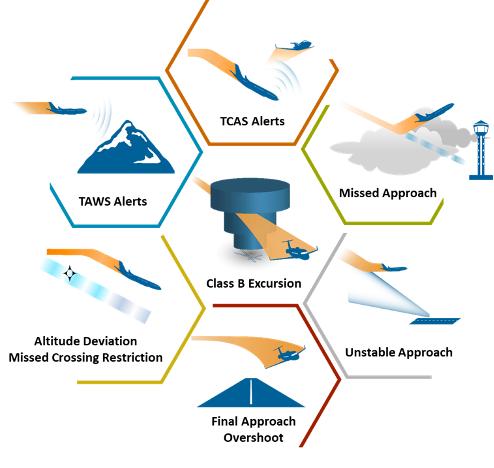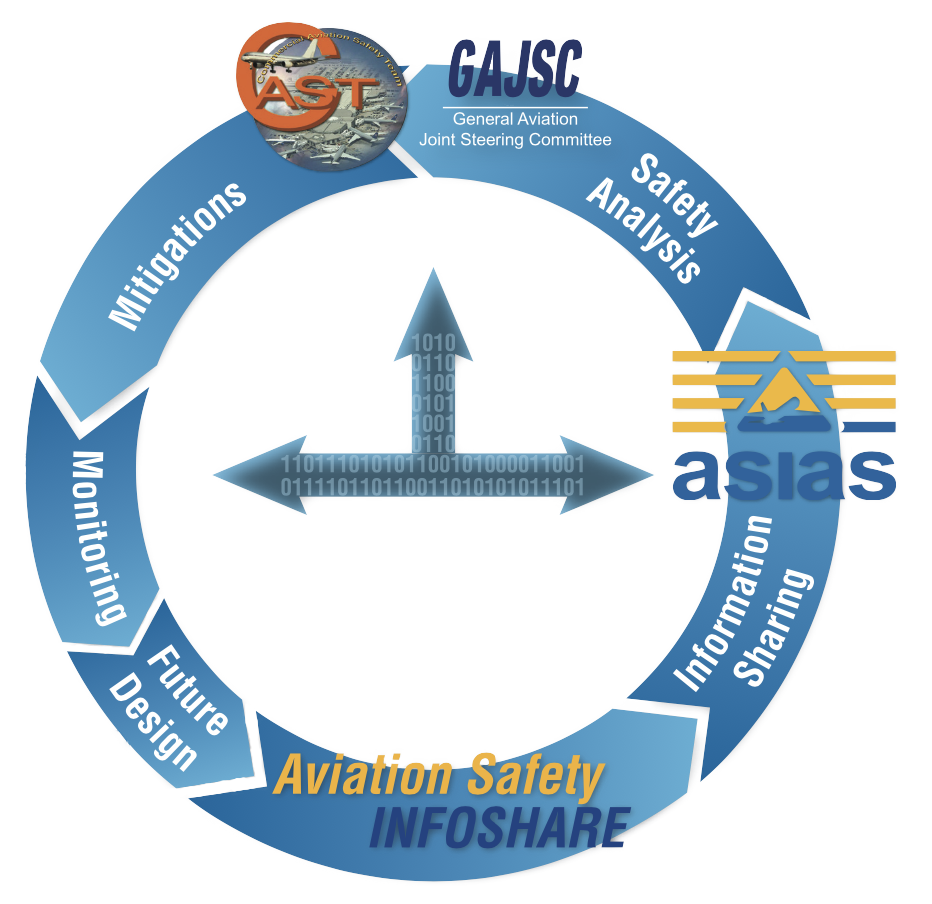
ASIAS’ Mission
Enhancing Safety Through Collaboration
In 2007, the Federal Aviation Administration (FAA) and the aviation industry launched a collaborative safety analysis and data sharing initiative known as Aviation Safety Information Analysis and Sharing (ASIAS).
For many years, the aviation industry realized that risk-based assessments must be the foundation of safety-related decisions. Further, for data collection programs to be comprehensive and effective, the aviation industry recognized that all stakeholders — government, manufacturers, operators, and employee groups — must establish a reporting culture based on trust and focus on proactive mitigation of adverse outcomes. ASIAS is built on these beliefs. The dedicated safety professionals who created this initiative established mechanisms and forums for sharing data. Most importantly, they established trust among stakeholders by guaranteeing that sensitive data would be used only to advance safety in accordance with the guiding principles of the ASIAS program.
Today, ASIAS leverages proprietary safety data from operators, manufacturers, publicly available records, and other aviation industry sources to monitor known risks, evaluate the effectiveness of deployed mitigations, and identify emerging hazards. ASIAS stakeholders provide data, help contextualize it during analyses, and collectively draw conclusions and establish best practices.
The Guiding Principles
- ASIAS information is used solely for the identification, monitoring, and mitigation of system-wide safety issues. It is not used punitively.
- ASIAS stakeholders voluntarily submit safety-sensitive data.
- Data is de-identified to preserve anonymity.
- Roles and responsibilities of ASIAS stakeholders are developed collaboratively.
- ASIAS data use is transparent to all stakeholders and supporting organizations.
- The United States Aerospace Safety Team (USAST) is responsible for safeguarding the trust stakeholders have placed in ASIAS. Further, the USAST assures the integrity and relevance of each analysis through careful deliberation.
ASIAS has enabled the aviation community to transition from a reactive approach for managing safety to a forward-looking, proactive approach.
It is an active and robust example of how dedicated collaborative data sharing initiatives can have a positive impact in advancing safety.
Collaborative Private-Public Partnership
ASIAS a collaborative data sharing partnership between the aviation industry and FAA/U.S. Government. It is a first of its kind collaborative program focused on safety data analysis and sharing. Since ASIAS’ inception, The MITRE Corporation (MITRE) has served a trusted partner to government, industry, and academia in shaping and operating ASIAS. MITRE is uniquely positioned to serve as the prime partner for ASIAS due to its proven ability to ensure:
- All data submitted by stakeholders is owned by the submitting stakeholder and will not be directly accessible by any other stakeholder.
- There is no actual or perceived conflict of interest — including commercial interest — in the stakeholders data or the partnership itself.
- Stakeholders expectations codified in the ASIAS agreements are honored — including protecting stakeholders data from improper use/disclosure and respecting intellectual property and other equities — based on long-standing legal/compliance practices and security and privacy controls honed on decades of experience safeguarding highly sensitive data.
What Does ASIAS Do?
1. COLLECT
The ASIAS process begins with the intake, integration, and de-identification of aviation safety data, such as, text-based and digital flight data. The data collection stage also involves “fusing” data-including safety report data with flight recorder and surveillance data—to create a wholistic “flight story.” Crucially, ASIAS protects proprietary data through de-identification of information, such as names used in safety reports, ensuring the focus remains on addressing systemic safety issues in a non-punitive manner.
2. ANALYZE
ASIAS analyzes de-identified proprietary data to gain insight on safety issues in the National Airspace System (NAS) from a variety of perspectives.

Sample of safety issues examined by ASIAS
- Safety Issue Identification is analysis to identify and understand systemic safety issues before they contribute to an accident or incident. Potential issues are identified through tips from the field and by applying artificial intelligence and machine learning analytical capabilities to reveal patterns in ASIAS data.
- Directed Studies in collaboration with the United States Aerospace Safety Team (US AST) are comprehensive examinations of underlying contributing factors and existing barriers of systemic safety issues. The results are shared with government and industry safety teams, such as the United States Commercial Aviation Safety Team (US CAST) and the United States General Aviation Joint Safety Committee (US GAJSC), to develop voluntary mitigations and reduce the likelihood of accidents and serious incidents in the future.
3. MONITOR
ASIAS monitors known aviation safety risks through analytical metrics, which provide ASIAS stakeholders and safety teams with the basis for system-wide decision-making.
- Benchmarks allow operators to compare their operational data against an aggregate de-identified norm.
- Metrics allow safety teams to monitor safety trends, detect safety issues, and assess effectiveness of implemented safety enhancements.
Benchmarks and Metrics are shared with stakeholders via the ASIAS Portal, an online platform for participants to stay up to date on aviation safety concerns.
4. COLLABORATE
Once a potential systemic safety issue is identified, the ASIAS Safety Issue Working Group (SIWG) conducts an initial evaluation of the issue. The SIWG collaboratively shares findings with the United States Safety Assurance Team (USSAT), enabling the USSAT to decide to submit the safety issue to the Aerospace National Safety Issue Registry (ANSIR) and to proceed with further analysis. As needed, safety teams further study the safety issue for future action, including (but not necessarily limited to) a safety risk assessment of an accident or serious incident.
ASIAS also collaborates internationally. For example, ASIAS has shared detailed safety metric definitions as well as aggregate, de-identified results to Regional Aviation Safety Groups (RASGs) in Pan-America (PA) and Asia Pacific (APAC).
5. CONNECT

The ASIAS Lifecycle
ASIAS conducts outreach to new aviation communities (e.g., rotorcraft) and domains (e.g., aircraft maintenance organizations and dispatch operators) to increase program participation.
Additionally, Aviation Safety InfoShare meetings, attended by government and aviation industry members, provide a unique opportunity for organizations to share safety issues and best practices to help raise awareness across the aviation community. ASIAS leverages the knowledge gained at InfoShare to search its data repositories to identify potential systemic safety issues.
